|
|

|
|
Author
|
Topic: SpaceX Dragon CRS-3 flight to the space station
|
Robert Pearlman
Editor Posts: 42988
From: Houston, TX
Registered: Nov 1999
|
 posted 03-19-2014 05:25 PM
posted 03-19-2014 05:25 PM
   
SpaceX release SpaceX CRS-3 Mission OverviewAfter three flights to the International Space Station (ISS), including two contracted resupply missions for NASA, SpaceX is set to launch its third Commercial Resupply Services (CRS) mission to the orbiting laboratory. The SpaceX CRS-3 mission is targeting a launch at 3:25 p.m. EDT (1925 GMT) April 18 from Launch Complex 40 at the Cape Canaveral Air Force Station, Florida. If all goes as planned, Dragon will arrive at the station on April 20, when it will be grappled and berthed to the complex. 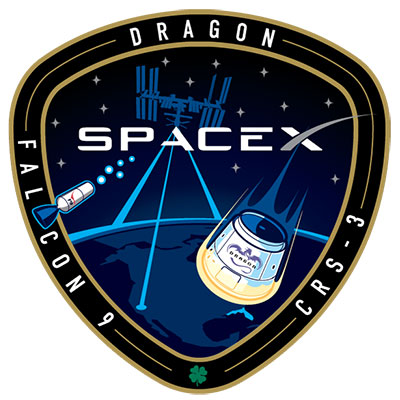 Background and Purpose SpaceX CRS-3 is the third of at least 12 missions to the International Space Station that SpaceX will fly for NASA under the Commercial Resupply Services (CRS) contract. In December 2008, NASA announced that SpaceX's Falcon 9 launch vehicle and Dragon spacecraft had been selected to resupply the space station after the end of the space shuttle program in 2011. Under the CRS contract, SpaceX is restoring an American capability to deliver and return significant amounts of cargo, which could include live plants and animals, to and from the orbiting laboratory. Cargo Dragon will be filled with about 4,600 pounds (2,100 kg) of supplies and payloads, including critical materials to support more than 150 investigations that will occur during Expeditions 39 and 40. Dragon will carry four powered cargo payloads in its pressurized section and two in its unpressurized trunk, a first for SpaceX. Dragon will return with about 3,600 pounds (1,600 kg) of cargo, which includes crew supplies, hardware and computer resources, science experiments, biotechnology, and space station hardware. Science payloads include the Optical Payload for Lasercomm Science (OPALS), which will test the use of laser optics to transfer information to Earth from space; the Vegetable Production System (VEGGIE), a unit capable of producing salad-type vegetables in space; and the T-Cell Activation in Aging experiment that seeks the cause of a depression in the human immune system while astronauts are in microgravity. In addition, the High Definition Earth Viewing (HDEV) investigation includes four high-definition cameras to be placed on the space station's exterior for use in streaming live video of Earth for online viewing. Secondary Payloads Falcon 9 will deliver five CubeSats to orbit as part of the CRS-3 mission, contained in four Poly Picosatellite Orbital Deployers. See here for discussion of SpaceX's third Dragon CRS flight to the ISS. |
Robert Pearlman
Editor Posts: 42988
From: Houston, TX
Registered: Nov 1999
|
 posted 04-10-2014 10:27 AM
posted 04-10-2014 10:27 AM
   
SpaceX photo release Dragon got a few upgrades since its last trip to station.To support more critical science payloads for the ISS, the spacecraft flying on Monday has nearly four times its previous powered cargo capability. Dragon will carry additional freezers in its pressurized section and for the first time ever, powered cargo inside its unpressurized trunk – NASA's OPALS and HDEV experiments. The spacecraft is also sporting redesigned cargo racks to accommodate the additional payloads.  |
Robert Pearlman
Editor Posts: 42988
From: Houston, TX
Registered: Nov 1999
|
 posted 04-14-2014 03:17 PM
posted 04-14-2014 03:17 PM
   
Helium leak scrubs SpaceX launch attemptSpaceX scrubbed Monday's (April 14) launch of the CRS-3 mission at 3:39 p.m. EDT (1939 GMT) due to a helium leak from the Falcon 9 rocket's first stage. A SpaceX representatives said that the company expects to be able to resolve the issue in time for their next launch opportunity on Friday (April 18) at 3:25 p.m. EDT (1925 GMT). The weather forecast for Friday however, calls for only a 40 percent chance of favorable conditions. |
Robert Pearlman
Editor Posts: 42988
From: Houston, TX
Registered: Nov 1999
|
 posted 04-16-2014 09:09 AM
posted 04-16-2014 09:09 AM
   
SpaceX confirms Friday for next launch attemptNASA and SpaceX have confirmed Friday (April 18) for the next launch attempt for the Falcon 9 rocket to send the Dragon spacecraft on the company's third commercial resupply mission and fourth visit to the space station. Launch is scheduled for 3:25 p.m. EDT (1925 GMT). A launch on Friday results in a rendezvous with the space station on Sunday (April 20) and a grapple at 7:14 a.m EDT (1114 GMT). The U.S. Air Force 45th Weather Squadron forecast predicts a 40 percent chance of favorable weather, with a chance of showers and thunderstorms that could result in violating the Thick Cloud, Lightning and Flight Through Precipitation rules. SpaceX has settled on a backup launch date of Saturday, April 19 for the best pair of launch dates for the science payloads being delivered to the station. If needed, a Saturday launch would occur at 3:02 p.m. EDT (1902 GMT). This would be a three-day, rather than two-day, transit to the station with grapple on Tuesday (April 22). During Monday's (April 14) launch attempt, preflight checks detected that a helium valve in the stage separation pneumatic system was not holding the right pressure. This meant that the stage separation pistons would be reliant on a backup check valve.
No issue was detected with the backup valve and a flight would likely have been successful, but SpaceX policy is not to launch with any known anomalies. SpaceX has brought the vehicle back to horizontal and is replacing the faulty valve, as well as inspecting the system for anything that may have contributed to the valve not working as designed. |
Robert Pearlman
Editor Posts: 42988
From: Houston, TX
Registered: Nov 1999
|
 posted 04-18-2014 03:44 PM
posted 04-18-2014 03:44 PM
   
collectSPACE SpaceX launches science-packed Dragon capsule on space station supply runA commercial space freighter loaded with more than two tons of scientific experiments and supplies launched for the International Space Station Friday (April 18), after more than a month of delays. Space Exploration Technologies (SpaceX) Dragon capsule lifted off on a Falcon 9 rocket, also built by the company, at 3:25 p.m. EDT (1925 GMT) from Launch Complex 40 at the Cape Canaveral Air Force Station in Florida. Rain and low clouds earlier in the day threatened a scrub due to the weather, but conditions improved such that the flight could proceed. Other than apparently some soiled water splashing on the Falcon 9 as it left the pad, the launch went smoothly, Elon Musk, SpaceX CEO and chief designer, told reporters. "Everything looks great as far as the ascent phase of the mission," he said. "The rocket flight was perfect as far as we can tell." 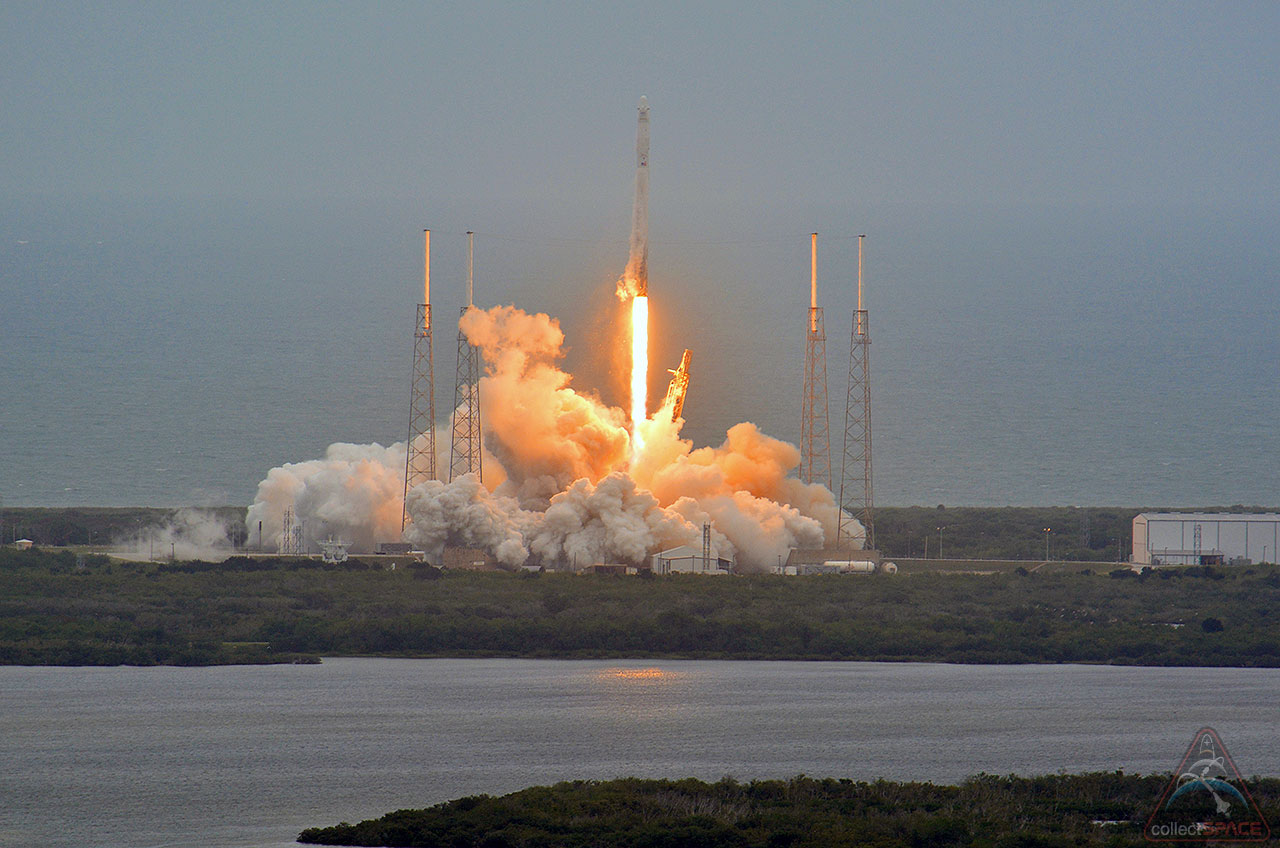 |
Robert Pearlman
Editor Posts: 42988
From: Houston, TX
Registered: Nov 1999
|
 posted 04-20-2014 06:17 AM
posted 04-20-2014 06:17 AM
   
CRS-3 Dragon arrives at space stationSpaceX's Dragon cargo spacecraft arrived at the International Space Station on Sunday morning (April 20), two days after launching from Cape Canaveral, Florida. 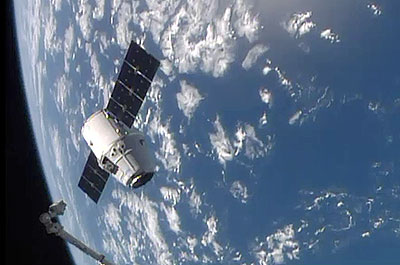 Expedition 39 crew members Koichi Wakata and Rick Mastracchio monitored the Dragon's approach from inside the station's Cupola. The rendezvous with the outpost went smoothly, though the capsule experienced several communication dropouts, which were resolved well within the 30-second allowance. Wakata was at the controls of the station's Canadarm2 robotic arm when it was moved in to capture the Dragon at 6:14 a.m. CDT (1114 GMT). At the time of grapple, the two spacecraft were 260 miles (420 kilometers) above the Nile River in Africa. "Capture is complete," Wakata radioed to NASA's Mission Control in Houston. "Congratulations to the entire ops team for the successful launch, rendezvous and capture operation." "The vehicle, the spacecraft, was very solid and very stable. And the Canadarm2 is really solid. It made it easy for us to capture," Wakata said. The Dragon was berthed to the station's Harmony module at 9:06 a.m. CDT (1406 GMT) while orbiting above Brazil. The hatch between the newly-arrived spacecraft and space station is scheduled to be opened on Monday. The Dragon is slated to spend 28 days at the outpost. |
Robert Pearlman
Editor Posts: 42988
From: Houston, TX
Registered: Nov 1999
|
 posted 05-18-2014 09:04 AM
posted 05-18-2014 09:04 AM
   
SpaceX's CRS-3 Dragon returning to EarthSpaceX's CRS-3 Dragon spacecraft departed the International Space Station on Sunday (May 18) after 30 days berthed to the orbiting outpost. The capsule is now set to splashdown in the Pacific Ocean, returning to Earth more than 3,500 pounds of NASA science samples and cargo. The Dragon was detached from the Earth-facing side of the station's Harmony module and unberthed through commands sent by robotic ground controllers at mission control in Houston operating the Canadarm2 robotic arm. Dragon was then maneuvered into place for its release at 8:26 a.m. CDT (1326 GMT). The Dragon then executed three thruster firings to move away from the station to a safe distance for its deorbit burn at 1:12 p.m. CDT (1812 GMT). The capsule will splash down just after 2 p.m. CDT (1900 GMT) in the Pacific Ocean west of Baja California. Dragon is the only space station resupply spacecraft designed to return to Earth intact. Among the 3,563 pounds of return cargo are science samples from human research, biology and biotechnology studies, physical science investigations and education activities. The spacecraft also will return crew supplies, vehicle hardware and spacewalk equipment. |
Robert Pearlman
Editor Posts: 42988
From: Houston, TX
Registered: Nov 1999
|
 posted 05-18-2014 02:46 PM
posted 05-18-2014 02:46 PM
   
NASA release SpaceX Dragon spacecraft returns critical NASA science from space stationSpaceX's Dragon cargo spacecraft splashed down at 2:05 p.m. CDT (1905 GMT) Sunday (May 18), in the Pacific Ocean, approximately 300 miles west of Baja California, returning more than 3,500 pounds of NASA cargo and science samples from the International Space Station. 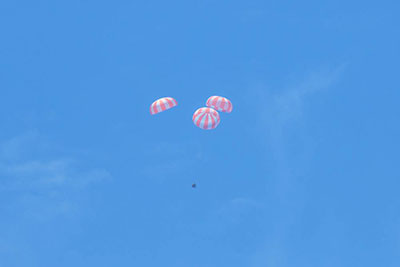 A boat will carry the Dragon spacecraft to a port near Los Angeles, where it will be prepared for a return journey to SpaceX's test facility in McGregor, Texas, for processing. Some cargo, including a freezer packed with research samples collected aboard the space station, will be removed at the port in California and returned to NASA within 48 hours. "The space station is our springboard to deep space and the science samples returned to Earth are critical to improving our knowledge of how space affects humans who live and work there for long durations," said William Gerstenmaier, associate administrator for human exploration and operations. "Now that Dragon has returned, scientists can complete their analyses, so we can see how results may impact future human space exploration or provide direct benefits to people on Earth." Investigations included among the returned cargo could aid in better understanding the decreased effectiveness of antibiotics during spaceflight while also improving antibiotic development on Earth. Others could lead to the development of plants better suited for space and improvements in sustainable agriculture. The T-Cell Activation in Aging experiment, which also launched to space aboard Dragon, seeks the cause of a depression in the human immune system while in microgravity. The research could help researchers develop better protective measures to prevent disease in astronauts. 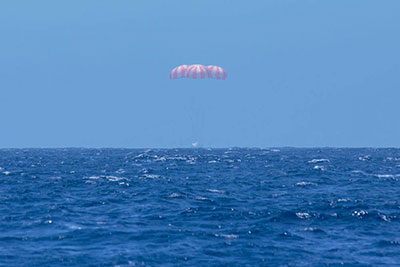 Dragon is the only space station resupply spacecraft capable of returning large amounts of cargo to Earth. The spacecraft lifted off from Cape Canaveral Air Force Station in Florida April 18, carrying approximately 5,000 pounds of supplies and science investigations to the space station. The mission was the third of at least 12 cargo resupply trips SpaceX plans to make to the space station through 2016 under NASA's Commercial Resupply Services contract. See here for discussion of SpaceX's third Dragon CRS flight to the ISS. | |
Contact Us | The Source for Space History & Artifacts
Copyright 2020 collectSPACE.com All rights reserved.

Ultimate Bulletin Board 5.47a
|
|

|
 advertisement advertisement

|

















